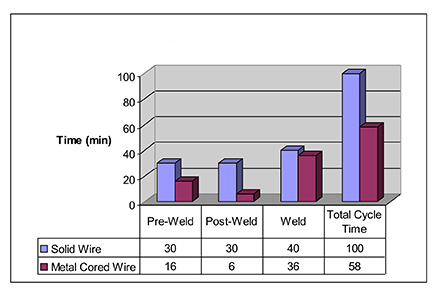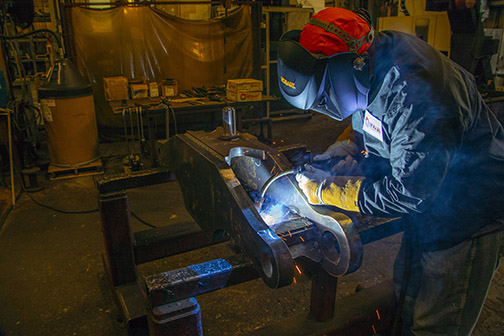How Metal-Cored Welding Wire Improves the Welding Operation
While every company has unique goals, all certainly want the same results for their welding operation: consistent productivity, high weld quality and profitability. The path each takes to achieve those results varies. For some, it may be a matter of investing in automated equipment or increasing their workforce. For others, a welding wire change could be the answer.
Metal-cored wire can bring improvements to the right welding application, and it has been especially successful in heavy equipment, automotive and general manufacturing. Considering a conversion to this welding wire, however, requires a holistic look at the welding operation. In many situations, metal-cored wire can increase efficiencies and reduce overall costs compared to solid wires.
If that’s the case, why are some companies reluctant to make a change to metal-cored wire?
The installed cost may factor into the equation, along with the comfort level of using solid wire, which is prevalent in many industries. There may also be some concern about welder acceptance of a new welding wire or about teaching welders a new welding process or technique. The trial and installation may seem daunting to others. These are all matters easily addressed working in conjunction with a trusted welding distributor and filler metal manufacturer throughout the conversion process.
That leads to a second question. What is the risk in not considering metal-cored wire for companies that are good candidates for a conversion?
In some cases, failure to convert means they may be less competitive in an increasingly competitive landscape or they may not reach the full productivity potential of their operation. They may also have to settle for higher rework or repair rates.
Who can benefit?
Metal-cored wire may help companies that are:
-Spending time and money cleaning prior to and after welding
-Currently welding 1.5 to 6 mm thick mild steel with solid wire
-Having poor fit-up, gaps or burn-through issues
-Experiencing inadequate side wall fusion
-Struggling to train less skilled welders
-Have high levels of scrap or rework
How it all adds up
Metal-cored wire is a composite tubular wire consisting of a metal sheath with a core of metallic powders and alloys. Its construction offers key benefits over solid wire that add up to cost savings.
1. Improved productivity. With the same welding wire size at the same operating parameters (amperage), metal-cored wire typically has a higher deposition rate, resulting in faster travel speeds for the same size weld. For example, at 350 amps, a 0.045-inch diameter metal-cored wire can operate at a wire feed speed of 566 inches per minute (ipm), resulting in a deposition rate of 14.9 lbs./hr. The same diameter solid wire welding at 350 amps is capable of a wire feed speed of 460 ipm and provides a deposition rate of 13.2 lbs./hr.
Metal-cored wire does cost more per pound than solid wire, but it can yield about a 30 percent increase in productivity. Faster cycle times mean more parts out the door and a better bottom line. In fact, a Southern United States-based company recently reported increasing its travel speed by 10 inches per minute and its weld penetration by 15 to 20 percent, resulting in faster production and an approximate savings of $365,000 annually.
2. Better labor utilization and fewer non-value-added activities. Labor accounts for around 85 percent of the total cost of most welding operations, with the remaining costs being divided between the welding wire (10 percent) and shielding gas (5 percent).
Labor encompasses more than just welding — it includes weld preparation, positioning and tacking, changing contact tips and welding wire spools, and potentially post-weld clean-up or rework. Of these, the cost for weld preparation and post-weld work can be reduced with metal-cored wires.
This welding wire eliminates the need for labor to clean mill scale, oil or dirt from the base material prior to welding and produces minimal spatter to reduce cleanup. It also provides good gap bridging and high weld quality to reduce labor for rework. Getting rid of these non-value-added activities not only reduces the cost for items like grinding wheels, grinders and anti-spatter solution (or for scrapped parts), it also gives companies the opportunity to reallocate labor to other areas of the welding operation where welders can help increase productivity.
As companies face a shortage of skilled labor in the industry, metal-cored wires can simplify training. New welders can typically pick up the appropriate welding techniques for metal-cored wire quickly, making them a productive part of the welding operation and adding to its profitability.

The cost of conversion
The cost to change to metal-cored wire is generally minimal, especially considering the projected overall savings in labor and rework and the increase in productivity. That especially holds true for metal-cored wire conversions on robotic welding systems. In some cases, it may be possible to increase productivity with this welding wire on existing equipment, as opposed to investing in additional robots.
The conversion involves a few key steps.
1. Welding operation study. This study can happen one of two places. The filler metal manufacturer can study the operation onsite or recreate the part production in its lab. In both cases, a specialist will establish the baseline for the current welding process with solid wire, looking at welding parameters (wire feed speed, amperage, voltage, etc.) and determining how long it takes to make the part. The part will then be welded with metal-cored wire and the faster travel speeds and deposition rates noted.
From there, it is possible to prorate the cost savings using metal-cored wire on per-shift, monthly or yearly basis.
2. In-house trial. After reviewing the data on metal-cored wire from the welding study, a company can trial it in a single welding cell within its operation, working with a filler metal specialist to optimize the parameters. According to the preference of the company, this trial may run for a day, week or even a month.
3. Potential welding procedure requalification. Depending on the application, it may be necessary for a company to requalify its welding procedure for use with metal-cored wires. In some cases, it may be possible do conduct the testing in-house. However, if additional Charpy V-notch or tensile strength testing is required, the company will need to work with a third-party testing lab to ensure the chosen metal-cored wire qualifies.
4. Conversion. The goal is to convert to metal-cored wire without interrupting production. This can occur by changing over one cell or a group of cells at a time or during routine weld cell maintenance. It may be necessary to make changes to the drive rolls at this time — metal-cored wires require V-knurled drive rolls.
Overcoming barriers to change
Change can be difficult at any time, whether it’s a personal matter or a business one. In the case of seeking improvements and cost savings with metal-cored wire, it is important to gain the acceptance of the welders who will be using the new welding wire on a daily basis. Communication about the welding process change and proper training are key to successful implementation. Helping welders understand that they are a critical part of the success and the profitability of the process can also go a long way in garnering support.
The conversion decision also requires that the decision makers — whether owners, purchasing agents or other stakeholders — look at the entire welding process to see the potential for overall gains. Don’t just look at the per pound welding wire cost.



